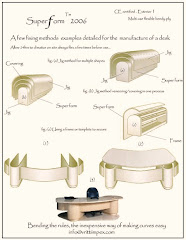This is one of those jobs you want to do once and do it right!
This was the keel manufacture and about 14 to 15 years back, Jeremy,Mike and Alfred are the men in the picture. Those top holes were so that internal welds could be done, Jeremy was the welder, later the 15mm thick steel plates removed for access were welded back in.
With the boat still upside down and with the keel stub fitted and completely flat, place a hardboard template on the keel stub and screw it in place. In this case the position of the 14 keel bolts given on the keel drawing from Dix Design www.dixdesign.com had already been set out, using white faced 3mm hardboard is a good plan.
The keel bolt holes can now be drilled, use a smaller drill bit as the pilot hole, you will need to have the shank of suitble drill bits extended, if its a twist bit your using lay the drill bit and the extention steel part in a steel channel, welding in the V ensures the two parts will be straight.
Dix Design will probably give you two options for fastening the steel keel to a wood/epoxy hull construction, do you want the keel to be removable, or fixed. The method in the pictures chose the fixed option. With that option you drill the keel bolt holes 3mm larger than the keel bolt studs that will be welded into position by the keel box manufacturer, he will require that template you made, just double check its laid on the keel box plate the right way up!
The idea with the fixed keel is that when the boat has been loaded onto the steel keel box, the extra holes around the threaded 316 steel studs is then back filled with liquid epoxy. In this case the top of the steel keel was further bonded with a 5ltr mix of 816 epoxy and graded teak wood flour, that was to bond the top surface to the boats keel stub.
A special day, this is about 38 months into the project, the boat was finished internally at the then new HBYC boat yard in Hout Bay harbour. This very moment was probably more exciting than the boats launch the following day, check the small face on the otherside of the boat, would all those studs and pipes fit was on the mind right then.
What a great moment!
The next day was antifouls, the return of the crane and the lift to the road trailer for a short move to the harbour wall a few hundred meters away.
The lines of the boat at last make sense, she sails as she looks, fast and comfortable, the first Dix 43 in wood/epoxy ever built.
Roy
Picture taken with Sony 3mp, Cybershot digital camera.
With the boat still upside down and with the keel stub fitted and completely flat, place a hardboard template on the keel stub and screw it in place. In this case the position of the 14 keel bolts given on the keel drawing from Dix Design www.dixdesign.com had already been set out, using white faced 3mm hardboard is a good plan.
Crane day, thats Doreen McBride standing there, all pictures except the first one are by Rob McBride.
The keel bolt holes can now be drilled, use a smaller drill bit as the pilot hole, you will need to have the shank of suitble drill bits extended, if its a twist bit your using lay the drill bit and the extention steel part in a steel channel, welding in the V ensures the two parts will be straight.
The keel, six tons of it, an application of 816 epoxy and graded teak flour is the sealant.
Dix Design will probably give you two options for fastening the steel keel to a wood/epoxy hull construction, do you want the keel to be removable, or fixed. The method in the pictures chose the fixed option. With that option you drill the keel bolt holes 3mm larger than the keel bolt studs that will be welded into position by the keel box manufacturer, he will require that template you made, just double check its laid on the keel box plate the right way up!
Ian was standing by to assist if required, the following day he helped me back fill the 14 x 20mm threaded rod 316 keel bolts, plus the 4 stainless steel acess pipes to the diesel tank space above the lead that had been hot poured into the keel.
The idea with the fixed keel is that when the boat has been loaded onto the steel keel box, the extra holes around the threaded 316 steel studs is then back filled with liquid epoxy. In this case the top of the steel keel was further bonded with a 5ltr mix of 816 epoxy and graded teak wood flour, that was to bond the top surface to the boats keel stub.
A special day, this is about 38 months into the project, the boat was finished internally at the then new HBYC boat yard in Hout Bay harbour. This very moment was probably more exciting than the boats launch the following day, check the small face on the otherside of the boat, would all those studs and pipes fit was on the mind right then.
What a great moment!
The next day was antifouls, the return of the crane and the lift to the road trailer for a short move to the harbour wall a few hundred meters away.
The lines of the boat at last make sense, she sails as she looks, fast and comfortable, the first Dix 43 in wood/epoxy ever built.
Roy









